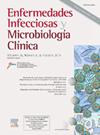VINCat项目成人重症监护病房器械相关感染率监测(2010-2022)
IF 2.6
4区 医学
Q3 INFECTIOUS DISEASES
Enfermedades infecciosas y microbiologia clinica
Pub Date : 2025-01-13
DOI:10.1016/j.eimc.2024.09.004
引用次数: 0
摘要
导言:监测是控制重症监护病房(UCI)中与器械相关的院内感染(NI)的重要组成部分。本研究旨在分析重症监护病房在过去 13 年中设备相关感染率的变化情况,包括呼吸机相关肺炎 (VAP)、导管相关血流感染 (CRBSI) 和导管相关尿路感染 (CAUTI)。材料与方法纳入2010年至2022年期间在VINCat计划43家参与医院的44个重症监护室住院的患者,考虑到三个时期:第一时期(2010-2013年)、第二时期(2014-2017年)和第三时期(2018-2022年)。医院根据规模分为三组:小型(200 张床位)、中型(200-500 张床位)和大型(500 张床位)。复杂性根据有创机械通气的使用情况进行评估。由一名具有丰富经验的重症监护医生记录每个病房至少连续三个月/年的 VAP、CRBSI 和 CAUTI 发生率。中心静脉导管的使用率为 0.6,从 0.59(大型医院)到 0.64(小型医院)不等。导尿管的耐用性为 0.66,范围为 0.65(大型医院)至 0.68(小型医院)。不同重症监护病房的复杂程度影响了不同设备的耐用性以及与之相关的感染率。每 1000 个器械日的 VAP、CRBSI 和 CAUTI 平均发生率分别为 6.4、1.9 和 3.4 次。监测系统提供了重症监护室内感染的信息。重症监护室的复杂性(以使用机械通气的情况来衡量)会影响设备相关感染。本文章由计算机程序翻译,如有差异,请以英文原文为准。
Surveillance of device-associated infection rates at adult intensive care units in the VINCat program (2010–2022)
Introduction
Surveillance is an essential part of the control of device-related nosocomial infections (NI) in intensive care units (UCIs). The aim of this study was to analyze the evolution of device-related infection rates in ICUs over the last 13 years, including ventilator-associated pneumonia (VAP), catheter-related bloodstream infection (CRBSI) and catheter-associated urinary tract infection (CAUTI).
Material and methods
Patients admitted to the 44 ICUs at 43 participating hospitals of the VINCat Program from 2010 to 2022 were included, taking into account three periods: first period (2010–2013), second period (2014–2017) and third period (2018–2022). Hospitals were classified into three groups according to their size: small (<200 beds), medium (200–500 beds) and large (>500 beds). Complexity was assessed based on the use of invasive mechanical ventilation. The incidence rate of VAP, CRBSI and CAUTI was recorded at least during three consecutive months/year in each unit by an intensivist with extensive experience.
Results
The device utilization ratio (DUR) of mechanical ventilation was 0.39, varying between 0.38 in large hospitals and 0.42 in small hospitals. The DUR of central venous catheter was 0.6, ranging from 0.59 (large hospitals) to 0.64 (small). The DUR of urinary catheter was 0.66, with a range of 0.65 (large hospitals) to 0.68 (small). The complexity of the different ICUs influenced the DUR of the different devices and the infections associated with them. The average rates of VAP, CRBSI, and CAUTI were 6.4, 1.9, and 3.4 episodes per 1000 device days respectively.
Conclusions
Surveillance systems provide information on intra-ICU infections. ICU complexity, measured in terms of the use of mechanical ventilation, influences device-associated infections.
求助全文
通过发布文献求助,成功后即可免费获取论文全文。
去求助
来源期刊
CiteScore
2.10
自引率
8.00%
发文量
194
审稿时长
29 days
期刊介绍:
Hoy está universalmente reconocida la renovada y creciente importancia de la patología infecciosa: aparición de nuevos agentes patógenos, de cepas resistentes, de procesos con expresión clínica hasta ahora desconocida, de cuadros de una gran complejidad. Paralelamente, la Microbiología y la Infectología Clínicas han experimentado un gran desarrollo como respuesta al reto planteado por la actual patología infecciosa. Enfermedades Infecciosas y Microbiología Clínica es la Publicación Oficial de la Sociedad Española SEIMC. Cumple con la garantía científica de esta Sociedad, la doble función de difundir trabajos de investigación, tanto clínicos como microbiológicos, referidos a la patología infecciosa, y contribuye a la formación continuada de los interesados en aquella patología mediante artículos orientados a ese fin y elaborados por autores de la mayor calificación invitados por la revista.

 求助内容:
求助内容: 应助结果提醒方式:
应助结果提醒方式:


